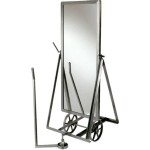Why Are Mirrors So Expensive?
Mirrors, seemingly simple objects reflecting our everyday lives, can surprisingly command high prices. While the basic concept of a reflective surface may appear straightforward, the manufacturing process and materials involved can be complex and costly, contributing significantly to the overall expense.
Material Costs and Quality
The primary material in most mirrors is glass, specifically a type of high-quality, low-iron float glass. This type of glass is chosen for its clarity and lack of the greenish tint found in standard glass, which is caused by iron impurities. Producing this specialized glass requires precise manufacturing processes and careful control of raw materials, adding to the cost. The larger the mirror desired, the more expensive the glass sheet becomes, both due to increased material usage and the higher risk of breakage during production and transportation.
Beyond the glass itself lies the reflective coating. Traditionally, silvering was used, applying a thin layer of silver to the back of the glass. While silver offers excellent reflectivity, it is prone to tarnishing. Modern mirrors often utilize aluminum, which is more resistant to oxidation and offers comparable reflectivity. However, the process of applying this thin, uniform coating requires specialized equipment and controlled environments, further increasing manufacturing costs.
Different types of mirrors may also incorporate other materials, like copper for antique-style mirrors or dielectric coatings for specialized applications. These specialized coatings can offer enhanced reflectivity, durability, or specific filtering properties, but they also add to the overall cost of production.
Manufacturing Processes and Labor
Creating a mirror involves multiple intricate steps, demanding skilled labor and precise machinery. After the initial glass sheet is produced, it must be thoroughly cleaned and prepared for the reflective coating. This includes meticulous polishing and cleaning to ensure a flawless surface for optimal reflectivity. Any imperfections in the glass will be magnified in the reflection, so quality control is paramount throughout the manufacturing process.
The application of the reflective coating is a delicate process requiring specialized equipment and expertise. Whether it's silvering, aluminizing, or applying dielectric coatings, the process must be executed precisely to achieve a uniform and durable reflective surface. This requires trained technicians and controlled environments free from dust and other contaminants.
Following the coating process, the backing is applied to protect the reflective layer from damage and oxidation. This backing can be made from various materials, including paint, polymers, or specialized films. The application of this backing requires further processing steps and adds to the overall labor and material costs.
Size, Shape, and Customization
Larger mirrors inherently require more materials and are more challenging to manufacture and transport, increasing their price proportionally. Cutting and shaping glass into non-rectangular forms also adds complexity and requires specialized equipment and expertise. Intricate beveling or edgework, often seen in decorative mirrors, further adds to the labor and time involved in production, driving up the cost.
Custom-designed mirrors, incorporating unique shapes, sizes, or decorative elements, often involve bespoke craftsmanship and specialized techniques. These one-of-a-kind pieces can command premium prices due to the individualized attention and skilled artistry involved in their creation. The level of customization can significantly impact the final cost, reflecting the expertise and craftsmanship required.
Finally, framing adds another layer of cost. Frames can range from simple, utilitarian designs to elaborate, hand-carved works of art. The material, craftsmanship, and design complexity of the frame contribute significantly to the overall cost of the finished mirror.

Why Are Mirrors So Expensive 5 Important Factors To Know Moyes Glass

Why Are Mirrors So Expensive

Why Are Mirrors So Expensive

Why Are Mirrors So Expensive 5 Important Factors To Know Moyes Glass

Why Are Mirrors So Expensive Top 5 Reasons

Why Are Mirrors So Expensive Find Out Now Upgradedhome Com

Why Are Mirrors So Expensive

Why Are Mirrors So Expensive 5 Important Factors To Know Moyes Glass

Why Are Mirrors So Expensive Top 5 Reasons

Why Are Ganador Mirrors So Expensive Wayne Arthur Gallery








